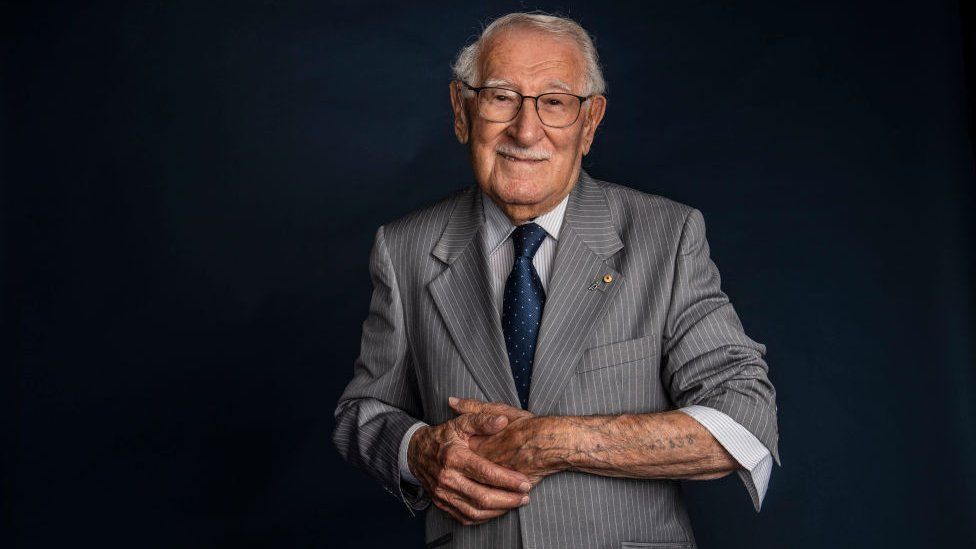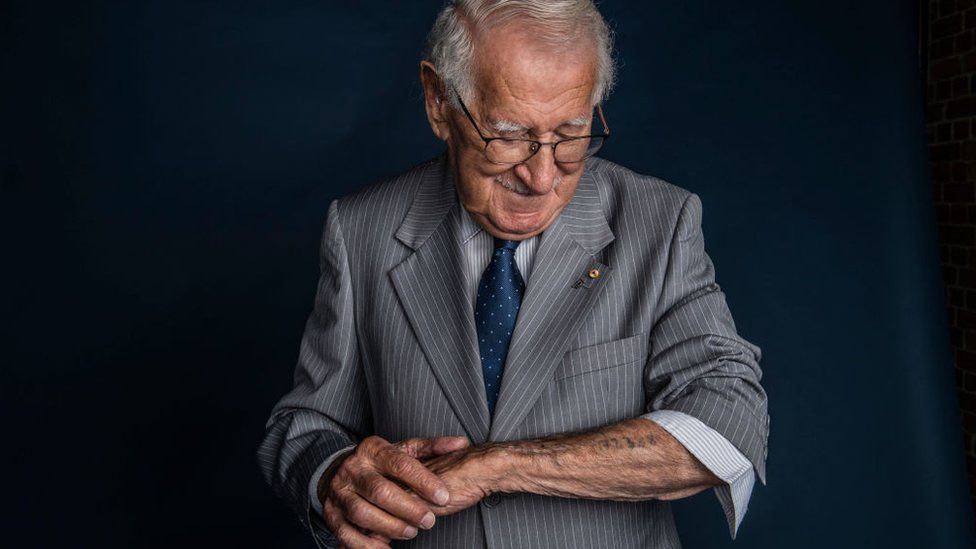Eddie Jaku: Holocaust survivor and peace campaigner dies aged 101
- Posted By: Studio
- International
- Updated: 26 April, 2024 22:28
- 174

Eddie Jaku, a Holocaust survivor who described himself as the "happiest man on earth" has died aged 101.
During World War Two, he was imprisoned in four concentration camps, led a daring escape on a train, broke free from a death march and survived in a forest.
Jaku dedicated the rest of his his life advocating for peace and kindness.
"I do not hate anyone. Hate is a disease which may destroy your enemy, but will also destroy you," he said.
Last year, to celebrate his 100th birthday, Jaku published his memoirs.
Entitled The Happiest Man on Earth, it chronicles his extraordinary story of survival, weaving in his messages of tolerance and forgiveness. It also made him one of the world's oldest published authors.
"I have lived for a century, and I know what it is to stare evil in the face," he wrote.
"I have seen the very worst in mankind, the horrors of the death camps, the Nazi efforts to exterminate my life, and the lives of all people. But I now consider myself the happiest man on earth."
Jaku died at a care home in Sydney; he had lived in Australia since in 1950. He is survived by his wife of 75 years, Flore, their sons Michael and Andre, four grandchildren and five great-grandchildren.
Australia's Prime Minister Scott Morrison described Jaku as "an inspiration and a joy" who "chose to make his life a testimony of how hope and love can triumph over despair and hate."
'A witness of the most tragic times'
Born Abraham Jakubowicz in Leipzig, Germany, in 1920, Jaku was the only Jewish student at his school - but that was not a problem, he said, until Adolf Hitler came to power.
Jaku's family sent him to a boarding school, where he used the alias Walter Schleif, out of fear that others might realise he was Jewish.
He studied mechanical engineering and graduated as the top apprentice toolmaker.
But when he arrived home on 9 November 1938 to surprise his parents for their wedding anniversary, no one was there.
It was Kristallnacht, the so-called Night of Broken Glass - when Jewish homes, businesses and synagogues were attacked throughout Germany and Austria. Many were killed and tens of thousands of Jews were rounded up and sent to concentration camps.
Jaku's family had already gone into hiding and the 18-year-old was all alone except for the family's dachshund Lulu.
At 5am, ten Nazi soldiers smashed down the door. In Jaku's memoir, he described how they brutally beat him, made him watch as they destroyed his family's 200-year-old home, and killed Lulu.
One of the soldiers started to engrave a swastika into Jaku's arm with his bayonet, he wrote.
"In front of my eyes, I lost my dignity, my freedom, and my faith in humanity.
"I lost everything I lived for. I was reduced from being a man to being nothing," Jaku said during a speech in 2019.
He was taken to Buchenwald concentration camp, but released five months later to work in a factory making tools.
He described how his father picked him up from the camp to take him to his new job - but instead they fled to the border and were smuggled into Belgium.
They were caught by Belgian police and once again locked up - not for being Jewish this time, but as German refugees.
After 11 months he was out and travelled to France, where he was eventually arrested in Lyon and sent to Gurs concentration camp.
Seven months later, Vichy France started deporting Jews, and Jaku found himself on a train bound for Auschwitz.
He described how, before boarding, he stole a hammer, screwdriver and spanner from the train platform.
"I went to the train driver and asked him in French how long it would be until the train entered Germany," he wrote.
"It would be nine hours. I had nine hours to get out, after which there would be no hope of freedom."
It took nearly all that time to unscrew and chip away at the interlocked floorboards of the train carriage, but he was eventually able to do it. When the train was just a few kilometres out from Strasbourg, Jaku and eight other prisoners were able to wriggle underneath the carriage, he wrote.
He described how they "crawled through like spiders, clinging to the bottom of the train car" until it was slow enough to safely drop onto the tracks, where they lay as flat as they could between the sleepers.
The plan worked - they were not spotted and Jaku escaped back to Belgium where he secretly lived with his parents and sister in an attic.
For two months, his two aunts lived with them in the tiny space. However one day they went back to the family's old apartment in Brussels, where the Gestapo were waiting for them.
The women were arrested and put on a train to Auschwitz, but they did not survive the trip.
"Their train was diverted along the way and sealed in a tunnel, where it was allowed to fill with fumes, killing every man, woman and child aboard," Jaku wrote.
He was never able to find out where they were buried or their ashes scattered.
"This breaks my heart still, after all these years."
In October 1943, along with the rest of his family, he was arrested and sent to Auschwitz - "my hell on earth" as he described it.
His mother, aged 43, and his father, aged 50, were murdered in a gas chamber. Jaku was spared because of his engineering skills, he wrote.
In his memoir, Jaku described hearing people being killed throughout the night, or taking their own lives by throwing themselves on the electric fences. Jaku admitted there were times when he wanted to do the same, but his friend Kurt would not let him.
"Auschwitz was a living nightmare, a place of unimaginable horrors", he wrote. "But I survived because I owed it to my friend Kurt to survive... One good friend can be your entire world."
He did try to escape however - and succeeded until a Polish farmer shot him in the leg. Jaku wrote that he realised "with horror" that he would never survive if the local Polish people would not help him.
He decided the only option was to return to the camp. Timing it with the factory workers' shift change, he wrote that he simply walked back into Auschwitz - the Nazis never even realised he had been gone.
In 1945 as Soviet forces got closer to Auschwitz, the camp was evacuated. Tens of thousands of prisoners were made to walk enormous distances day and night with no food or water - these were the death marches.
He survived the first march and was sent to work in a factory at a smaller camp.
Jaku was put in charge of 200 machines, and wrote that he was made to wear a sign around his neck that said if any of them broke down - he was to be hanged. An impossible task, so Jaku said he made 200 whistles and gave one to each prisoner working the machines, to alert him to any issues.
One of those prisoners was his sister Henni, who had also survived.
When that camp was also evacuated, Jaku found himself on another march, but this time he managed to escape, and hid in a cave in a forest for about two months - eating slugs and snails to survive, he wrote in his memoir.
He described how he became seriously ill after drinking poisoned water from a stream, but managed to crawl to a highway where he was rescued by American soldiers.
It was June 1945 and the war was over.
But Jaku was in a bad way - he was malnourished and had cholera and typhoid. A nurse told him he had a 65% chance of dying, he said.
But he survived, and not long after the end of World War Two, married his wife Flore in Belgium. They moved to Australia in 1950, along with her mother Fortune and his sister Henni.
'The happiest man on earth'
Despite the nightmare he endured and the trauma he lived with, Jaku's lifelong message was clear - he did not hate anyone, and only ever wanted to spread messages of peace and forgiveness to try and heal the wounds that Adolf Hitler had inflicted on the world.
He was a longstanding volunteer at the Sydney Jewish Museum, sharing his story with visitors.











Comments